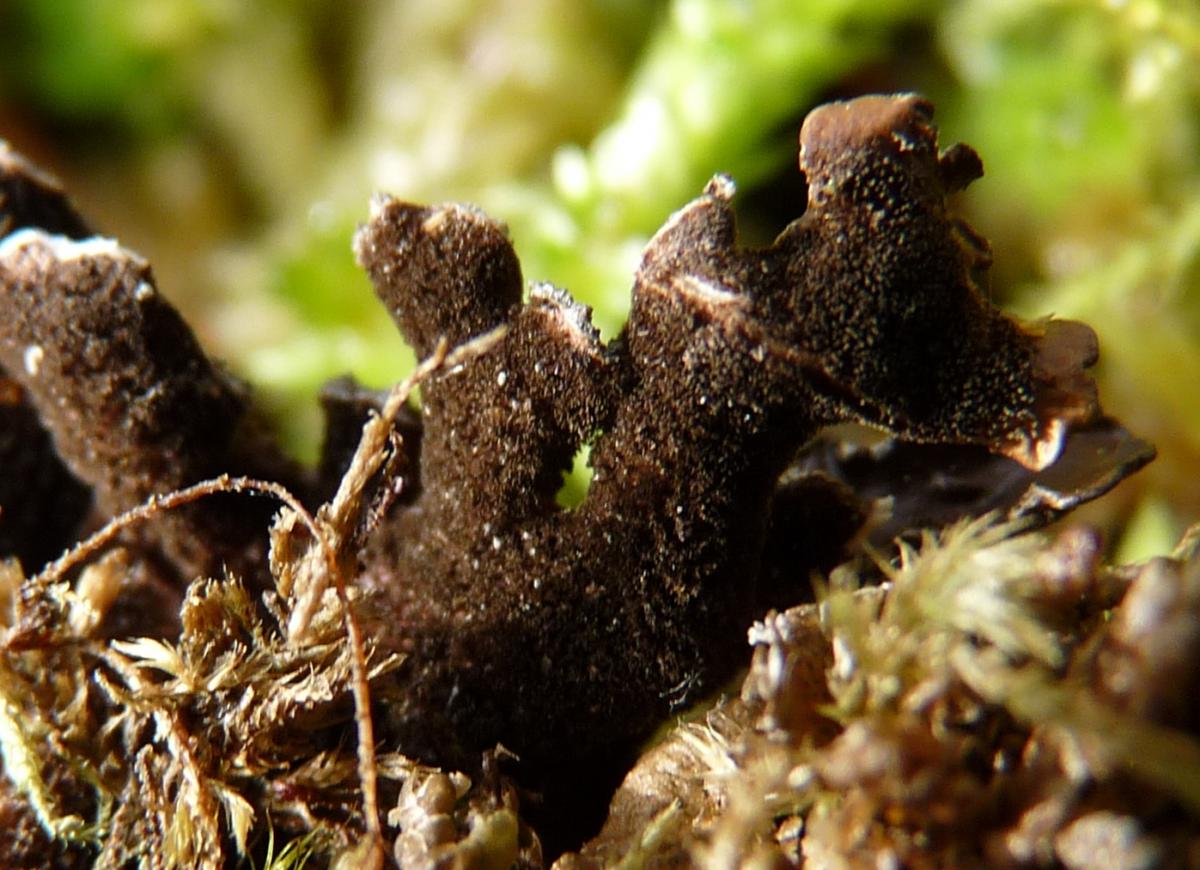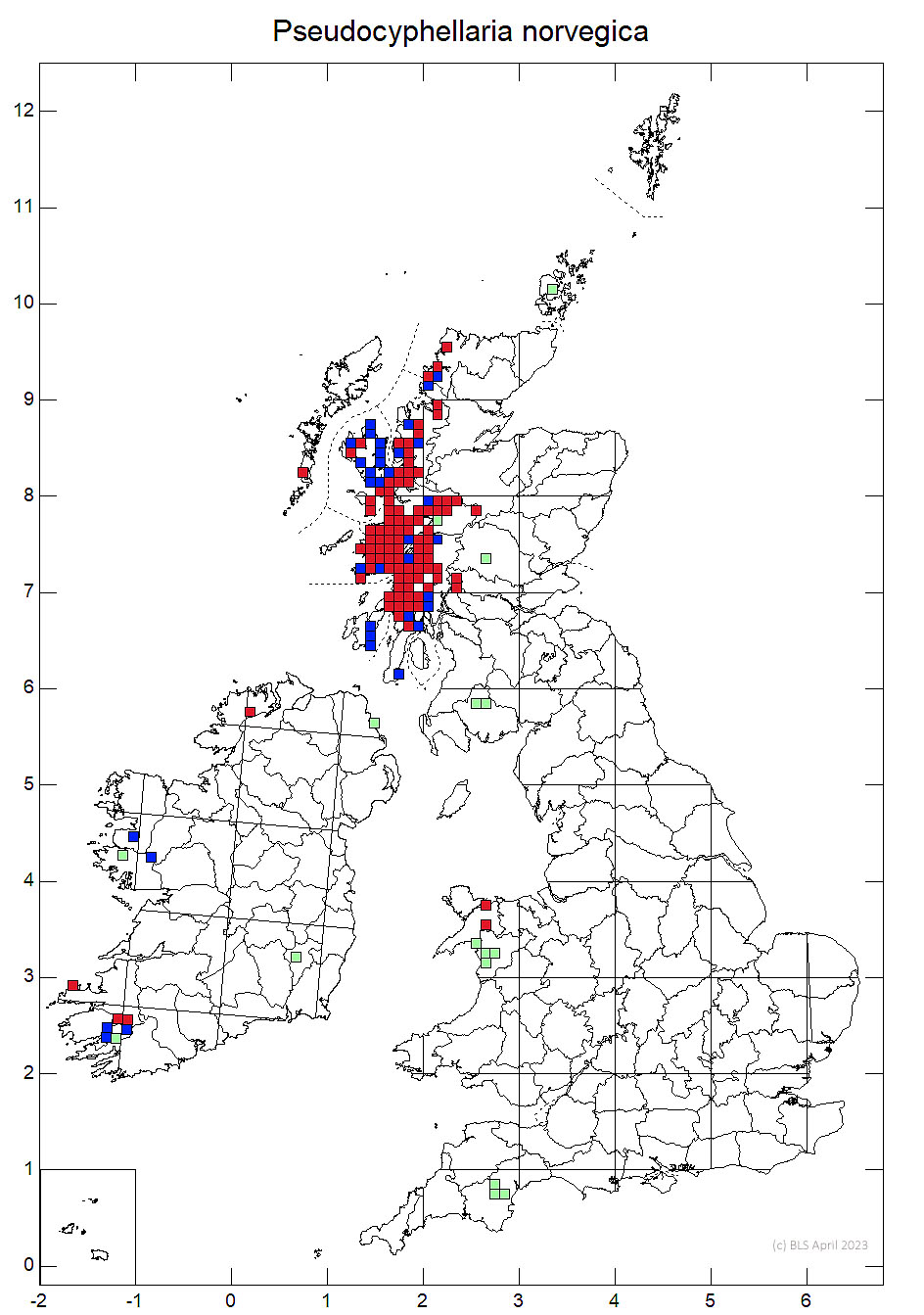This species was described new to science in 1979 (see Coppins & James (1979). It is a substantial foliose lichen with, when moist, a brown thallus that becomes grey-brown on drying out. Its surface is smooth, though it may develop ridges. The purple grey coloured eruptions of soralia along the lobe margins and scattered in dots or somewhat more elongated squiggles over the surface of the thallus are a prominent feature. It might be mistaken for a Nephroma or a Peltigera. The underside gives it away in that the Pseudocyphellaria is covered in a dense, dark brown stubble of rhizines. A careful search amongst the rhizines will also reveal the presence of small sunken bald patches, the pseudocyphellae that give it its generic name and the English name of the Americans-the speckle bellies. Peltigera has large bushy, rather widely spaced rhizines and Nephroma a bare undersurface. In Sticta limbata the undersurface and rhizines are much paler in colour and the rhizines less well developed.
 |
 |
| P. norvegica - upper surface.(Photo: R.G. Woods) | P. norvegica - lower surface. (Photo: R.G. Woods) |
PLEASE NOTE. All Pseudocyphellarias appear to exceptionally rare in Wales and you must not just rip up bits to look at the underside!! In dry weather take a small sprayer and water with you to moisten the thallus before carefully turning it over in situ. An illuminated hand lens is almost a must.
There have been three Pseudocyphellaria species recorded from Wales. All have white medullas. P. norvegica differs in having a C+ red and KC+ orange medulla and soralia. Its lobes are somewhat more rounded and ridged than the superficially similar P. intricata and there are more soralia scattered over the thallus surface. P. intricata tends to have more elongated smooth lobes with the soralia, at least initially, confined to the lobe margins. P. lacerata has cylindrical to branched isidia at the lobe margins and occasionally spreading over the lobe surface. Unfortunately occasionallyP. lacerata soredia can grow in situe to develop a cortex and so resemble isidia. If in doubt seek expert help.
It lives on somewhat basic mossy trunks and boulders in woodland or sheltered ravines in humid, oceanic areas. It is usually found in sites with a well-developed Lobarion community. At its Welsh site it is found with Sticta sylvatica, S. canariensis, Nephroma parile and Dimerella lutea amongst others. In Scotland it rarely occurs over 110m being mostly a species of coastal ravines. In Wales its only known site is at slightly over 200m.
There is only one recent Welsh record. It occurs on a basic rock outcrop in open ash/hazel woodland high up in the Nant Gwynant Valley facing Snowdon. This wood is probably the wettest in Wales. The rocks here support a fine Lobarion community but in the high rainfall the trees appear to be mostly too acidic for this community.
There are no other localised records. Pentecost (1987) reports it from SH61 and 71 but says there are no recent records and it is probably extinct. Coppins and James (1979) note pre 1950 records from SH53, 61 and 62 whilst Rose, Coppins and James (1998) note pre 1960 records from SH53, 61, 62 and 72 and a post 1960 record from SH65.
Near Ceunant Mawr, Gwynant Valley NE of Beddgelert, Caernarvonshire in the Snowdonia National Park SH6553. Last seen 2009 RGWoods.
It is only now known in Wales as a small number of colonies on a single rock outcrop. As such it is vulnerable to local catastrophic events such as rock falls. Recently a large ash tree collapsed and narrowly missed damaging these colonies. The site is in a National Park but is otherwise not afforded any other statutory protection. Acid rain presents an ongoing threat to this base-loving species and may limit its ability to colonise nearby tree in its one extant site.
This lichen may be extinct in England where it has not been seen for over 50 years.
In Scotland it is quite frequent in parts of the Western Highlands with post 1960 records from 80 ten km squares and 147 sites (Coppins & Coppins (1997)). On account of the significant population in Scotland this lichen is accorded a threat status in Britain of Least Concern though the British population is considered to be of international importance. In Wales it is considered to be Critically Endangered.
It has a limited distribution in the rest of the world with confirmed records from SW Norway (30 sites), Madeira, Falkland Isles and Juan Fernandez. A record from the Azores requires confirmation (Coppins & Coppins op cit.).
Coppins, AM & Coppins, BJ (1997). Pseudocyphellaria norvegica Species Dossier. A report to Scottish National Heritage and the Royal Botanic Garden Edinburgh.
Coppins, BJ & James, P (1979). New or Interesting British Lichens. Lichenologist 11: 139-179.
Pentecost, A (1987). The lichen flora of Gwynydd. Lichenologist 19:1-166.
Rose, F, Coppins, BJ and James, PW (1998).Pseudocyphelaria norvegica. Species account 1198/1998 in the third fascicle of the Lichen Atlas of the British Isles. British Lichen Society, London.
- Log in to post comments

